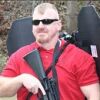As law enforcement officers, we deal with rules and regulations on a daily basis. Sometimes it’s enforcing the rules and regulations of the road by issuing traffic citations to those that violate them. Other times we find ourselves adhering to the rules and regulations that are set forth by our departments.
Whether enforcing or following, there seems to be a rule or regulation for just about everything we do. In keeping with that theme, let me give you the first rule of a gunfight: there are no rules.
So how do you prepare yourself for a gunfight if there are no rules?
The first thing you have to do is acknowledge that you are in a gunfight. You’re not standing next to your fellow coworkers on the range waiting for the whistle to blow, and punching holes in a paper target. Gunfights are very fast and very fluid things.
You need to be able to shoot and move, shoot while moving, and do so fast and accurately, and do it in low light as well.
Since there are no rules in a gunfight, let’s look at some of the facts of a gunfight. The majority of gunfights are up close and personal, not at the twenty-five yard line. Yes, they do happen at that distance occasionally, but they are far and few between and hardly worth the amount of training time we spend out at those greater distances.
Let’s face it, where do most officers have trouble hitting the target from: the twenty-five yard line or the five-yard line?
Why waste the amount of time that we do waste at those greater distances, when the majority of shootings are up close and personal?
I know some of you want to argue that “if they can hit the target from out there then they can hit it in close.” The facts are that a gunfight at twenty-five yards is a totally different animal than a gunfight that’s taking place a few feet, or a few inches, from you.
Some will argue that we want to “maintain our reactionary gap.”
That’s great, but how do you handcuff and search someone from ten feet away? How do you ID someone or conduct a field sobriety test from the twenty-five yard line?
Bad Breath Distance
The nature of our business is up close and personal, that’s why the majority of our shootings take place at that distance.
Until we all get robots to do our searches and field tests, we’re left to do the dirty work. That means we have to get in close to handcuff, ID, search, run field sobriety tests, etc. That being the case, we need to train at those close distances, and that means training on point shooting.
I know, I know, I’ve opened up the proverbial can of worms again, but facts are facts. In reality, every firearms instructor out there is teaching some form or another of point shooting.
Does your department teach weapon retention shooting? As your forearm is locked into your side with the gun canted away from your body, so the slide doesn’t get caught on your clothing, where is your sight picture there?
Does your department teach the shove-and-shoot drill where you shove the target and shoot it at close distance? How about hip shooting, or any other close quarters tactics where the gun is dropped below eye level? If so, then you’re learning point shooting.
Well, that’s if you’re doing these drills right. If you’re shoving the target and then waiting until you have enough distance between you and the target to bring your gun up to eye level before firing, then you’re doing the drill all wrong. Let alone that if you tried that on the street, you’d more than likely be on the losing end of that gunfight.
As we’ve seen on a number of occasions, the bad guys don’t always back away from us, creating some distance — sometimes they come right at us, and if you’re not prepared for that, you could be overwhelmed by it. A number of officers have been caught off guard and couldn’t believe the offender kept coming at them, even after the bad guy had been shot, and sometimes shot with multiple rounds.
Why where they caught off guard? Because they had never trained for that possibility.
In addition, you need to be trained to shoot multiple rounds. We all know that we shoot to stop the threat, but what exactly does that mean? Do we shoot one round, and then wait to see what the results are? Years ago it was the double tap.
You fired two rounds, stopped and assessed, and then fired two more rounds if necessary. It took us awhile to figure out that one wasn’t working, yet some departments still teach the dreaded double tap.
It takes the average person 4.6 seconds to bleed out to the point of unconsciousness from a center mass hit. That’s not death, that’s just to the point of unconsciousness. How many rounds can you fire in 4.6 seconds? Five? Six? Maybe more?
If you double tap the bad guy while he’s firing five or six into you at the same time, guess who’s going to bleed out to the point of unconsciousness? You need to fire — and keep firing — until the bad guy is down and no longer poses a threat to you or any innocent third parties.
That’s it for now. Check back next week for part two of this two-part series. There we’ll discuss the 1986 Miami firefight involving Platt and Matix.


